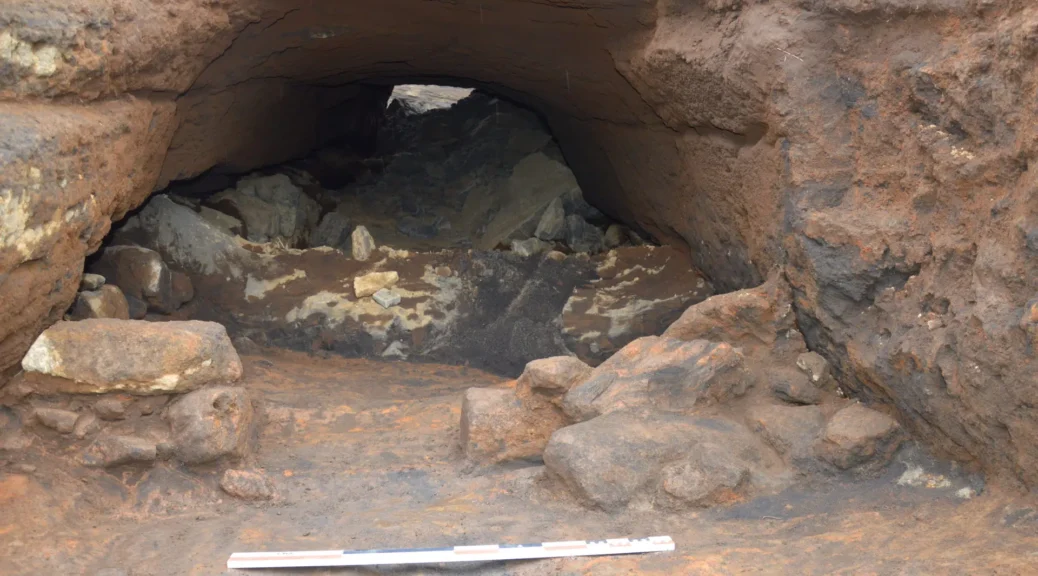Viking-Era Structures Explored in Iceland
Ongoing excavations of Viking-era, man-made caves near Oddi in South Iceland have revealed an extensive system of interconnected structures that is not only much larger than originally thought but also much older. Mbl. is reports that excavations, substantiated by tephra layers, show that the caves at Oddi were the first dugout in the middle of the 10th century.
“There really are no words to describe it,” archaeologist Kristborg Þórsdóttir said of the experience of standing in what is one of the best-preserved man-made structures of the Viking era. Kristborg is leading the current interdisciplinary study on the caves, which has been ongoing since 2020.
“The size of these structures is just so vast, there hasn’t been a study of such large structures, and definitely not from this time period in Iceland.”
An important medieval cultural and political centre
The first intact, man-made cave at Oddi was discovered in 2018, which was a remarkable discovery in and of itself. But further investigation of the site revealed a much larger cave connected to the first. It is this cave that is currently being excavated by Kristborg and her team.
The historic site of a church, farm, and vicarage, Oddi was once one of Iceland’s most important cultural and political seats and home to a powerful clan known as the Oddverjar. The current study has been ongoing for two years, with the primary aim of shedding light on the writing culture that was there during the 11th and 12th centuries, when the Oddverjar were at the height of their powers. Sæmundur fróði (Sæmundur the Learned, 1056-1133) was the most famous member of the clan. He studied in France and wrote one of the earliest histories of the Norwegian kings, although that manuscript was lost. Sæmundur’s grandson, Jón Loftsson, was a powerful chieftain who fostered Snorri Sturluson, the renowned historian, poet, and lawspeaker who is thought to have authored or partially authored major medieval works such as the Prose Edda (known as Snorri’s Edda in Icelandic), the most significant extant source on Norse mythology, as well as the Heimskringla, a saga of the Norwegian kings that was likely based on Sæmundur fróði’s lost manuscript.

A race against time
“We’ve just partially opened up the large, collapsed cave that our little cave is connected to,” explained Kristborg. “We still have deeper to dig; we’re just working on making conditions safe. It’s gotten very deep and the rock isn’t sound. So it’s taken some time.”
Kristborg notes that the excavation is unique in terms of how demanding on-site conditions are. The caves are not only at a significant depth, which is dangerous for the archaeologists involved in digging them out, but also built into sandstone. “The rock is so porous that it just crumbles before our eyes.” It’s thought that the caves were not used for very long because they are so prone to disintegration.
Resources for the archeologists also remain limited. “We only have limited funds and time and you never know what’s going to happen next year. Maybe we can continue, maybe not. And information is always lost from year to year, preservation gets worse.”
A long and complex history, waiting to be uncovered
Kristborg says that the cave currently being excavated may possibly be Nautahellir, Bull Cave, which is mentioned in Jarteinabók Þorláks Biskups (Bishop Þorlákur’s Legends of Saints), which dates back to 1210 – 1250. The manuscript relates how Nautahellir collapsed with 12 bulls in it. One was then rescued from the rubble.
“Although it’s older than that, it’s likely that [the cave] was used for livestock,” explained Kristborg. “Whether it was for that specific bull, we don’t know. But the history of its use obviously goes back further than we’ve managed to trace yet.”
The caves at Oddi have a complex and fascinating story to tell, says Kristborg, but the scope of the current investigation is such that she and her team need to keep their focus narrow. “These are huge structures and an unbelievably large system of caves that we’re only just starting to come to grips with. […] We’d need to undertake a much, much larger study with a much bigger crew in order to get to the bottom of this and trace this history in full, the history of these caves’ use.”
